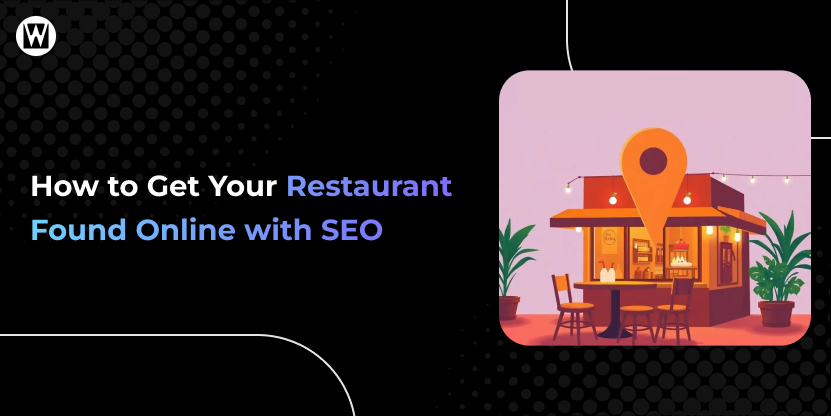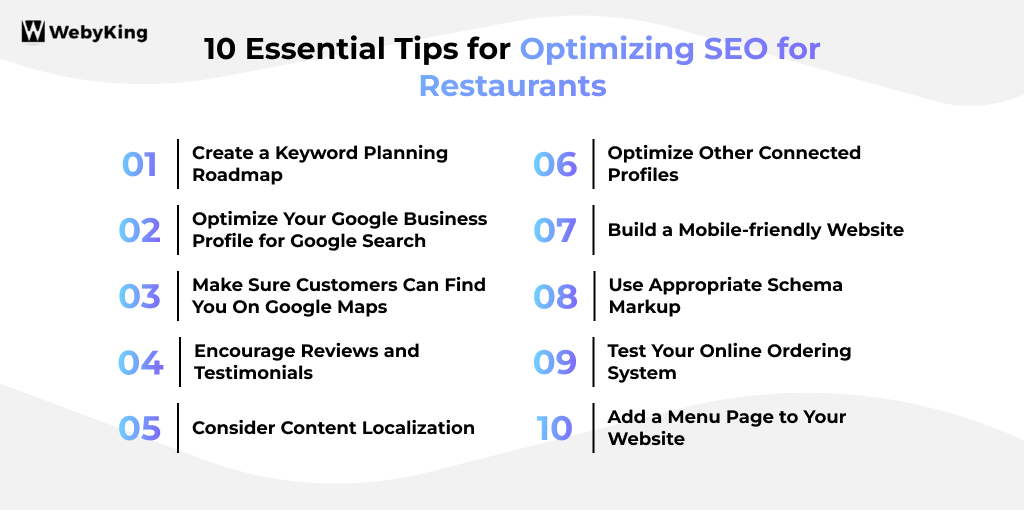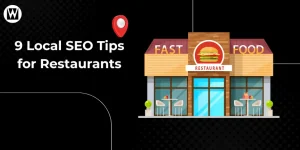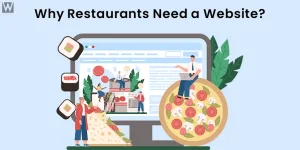How to Get Your Restaurant Found Online with SEO

Running a successful restaurant today isn’t just about great food and a welcoming atmosphere; it’s also about making sure people find you when they search for a place to eat.
When potential customers search for nearby dining options on Google, they’re presented with a variety of results: the Google map, local business listings, and articles recommending the best places to eat. As a restaurant owner, your goal is to show up in as many of these spots as possible. This is where restaurant SEO (search engine optimization) becomes essential.
Restaurant SEO ensures that your website ranks higher on Google, increasing your restaurant’s visibility and driving more traffic. The higher you appear in search results, the more likely customers are to find you and choose your restaurant.
If you’re just starting with restaurant SEO, don’t worry. Here, we will throw some light on how it works and explore strategies to help improve your search rankings, attract more customers, and make your restaurant stand out online.
What is Restaurant SEO?
Restaurant SEO (Search Engine Optimization) is the process of optimizing your restaurant’s online presence so it ranks higher in search engine results when people look for places to eat. It involves a combination of strategies, like improving your website content, targeting relevant keywords (e.g., “best Thai food in Singapore”), optimizing your Google Business Profile, and building positive online reviews.
The goal of restaurant SEO is simple: make it easy for customers to find you online, whether they’re searching for a specific cuisine, a nearby spot, or the best-rated place in town. It not only drives more organic traffic to your website but also increases reservations, takeout orders, and overall brand visibility.
In today’s competitive food industry, showing up on the first page of Google can be the difference between a full dining room and empty tables. SEO helps ensure you’re the one getting noticed—before your competitors do.
Why is SEO for Restaurants so Important?
SEO is the secret ingredient that helps restaurants move from hidden gems to everyone’s go-to choice when hunger strikes. With so many people searching online for where to eat next, ensuring your restaurant appears at the perfect moment can turn curious browsers into loyal diners.
Get Spotted First
Showing up at the top of local search results means more hungry folks find your place, especially when they search “best pizza near me” right from their phones. This visibility puts your menu front and center when it matters most, increasing foot traffic and online orders.
Pull in the Right Crowd
SEO isn’t about more clicks – it helps you attract people who want what you’re serving. Optimizing for the right keywords – (“vegan brunch in town”, for example) means the diners finding you are searching for exactly what you offer, making them more likely to book a table or order takeout.
Create a Smooth Online Experience
A restaurant website that’s fast, easy to navigate, and looks great on mobile isn’t a treat for your guests – it’s a recipe for better SEO too. A smoother online experience means visitors are more likely to stick around, check out your menu, and reserve a spot.
Compete (and Win) without Big Ad Budgets
Instead of pouring money into constant ads, SEO lets your restaurant get noticed organically, even when you’re closed. It’s a cost-effective way to reach diners who are actively looking for what you offer, delivering long-lasting results without blowing your marketing budget.
Build Trust with Potential Diners
Ranking highly in search results, displaying great reviews, and sharing updated info establishes your credibility with new customers. When people see that your restaurant consistently appears on top search spots, they’re more likely to trust you with their next meal.
Hence, we can say that investing in SEO isn’t just smart – it’s essential for making sure every dish you serve gets the audience it deserves.
10 Essential Tips for Optimizing SEO for Restaurants
Optimizing SEO for a restaurant opens the doors to more foot traffic, online orders, and loyal customers, right when hungry people are searching. A well-tuned strategy makes your business easy to find in those crucial “best place to eat near me” moments, giving you a serious edge in the local dining scene.

1. Create a Keyword Planning Roadmap
Think of keywords as the signposts that guide local customers and guests to your restaurants online. Without them, even the most mouthwatering dishes can get lost in the crowd.
Start by using tools like Google Keyword Planner, SEMrush, or Ahrefs to research the exact phrases people type when they’re hunting for food in your area.
For example, instead of only targeting “Italian restaurants,” you might uncover high-intent gems like “late-night Italian restaurant in Florida” or “authentic Neapolitan pizza near me.”
Tips for building your keyword plan:
- Group by intent: Some keywords are for discovery (“best rooftop cafe”), others lead to action (“book sushi table now”).
- Balance high and low competition: Go after popular searches, but don’t ignore niche ones like “vegan ramen downtown.” These smaller keywords can drive high-quality traffic that converts.
- Update seasonally: Search trends shift—think “summer patio dining” or “Christmas dinner reservations.”
With a solid roadmap of keywords, every page on your site serves a specific search intent, helping you rank higher and be found faster.
2. Optimize Your Google Business Profile for Google Search
Your Google Business Profile (GBP) is often the first impression people get of your restaurant. It pops up beside search results and on Google Maps, and can be the deciding factor for choosing you over your competitors.
Make sure your profile is complete and fresh:
- Add high-quality photos of your food, interior, and any unique features (like a rooftop or live music nights).
- Keep your opening hours accurate (especially for holidays).
- Use the “posts” features to promote daily, especially for events.
- Respond to reviews – both good and bad – to highlight customer care.
State to Note: Google says restaurants with more photos receive 42% more requests for directions and 35% more website clicks. That’s a big jump just from showing off your best dishes.
3. Make Sure Customers Can Find You On Google Maps
For many diners, the decision of where to eat happens directly on Google Maps. If you are not there or worse, if your location is wrong, you’re invisible to them.
Steps to shine on Google Maps:
- Verify your listing so you appear in local results.
- Ensure your PIN is dropped exactly where your entrance is located – especially if you’re inside a mall or complex.
- Add attributes like “family-friendly”, “wheelchair accessible”, or “dog-friendly” to attract the right crowd.
- Update location details if you ever move or open new branches.
When someone searches “Thai restaurant near me”, the list of restaurants along with Google Maps isn’t just showing distance – it’s showing trust. A complete, accurate GMB profile tells diners you’re ready to serve them now.
4. Encourage Reviews and Testimonials
Reviews are modern-day word of mouth, and they matter – a lot. According to BrightLocal, 76% of consumers regularly check online reviews before deciding where to eat.
Encourage reviews naturally by:
- Ask happy customers at the table or via follow-up emails.
- Printing a small review request card with a QR code linking directly to your Google review page.
- Offering incentives like “leave a review and get 10% off your next visit” (just be careful to request honest feedback, not only 5-star).
Always respond- even to the occasional negative review. A polite, solution-focused reply shows diners you care and can win back trust faster than ignoring criticism.
5. Consider Content Localization
Localization isn’t just about language – it’s about making your online presence feel local. Mention landmarks, neighboring areas, and seasonal events that your audience knows.
For instance, “We’re located in City Center”, you could say “Just a short walk from the Riverfront Park – perfect for diners after an evening stroll.”
Ways to localize content:
- Blog about local food festivals or charity events you’re part of.
- Use local slang or cultural references in your social media captions.
- Mention nearby attractions so tourists searching for those spots also see you in the results.
Localized content builds familiarity, trust, and a stronger connection with your audience (and Google loves that).
6. Optimize Other Connected Profiles
Many diners find restaurants through third-party platforms before ever visiting their site – think Yelp, TripAdvisor, OpenTable, and Facebook. Keeping these updated is crucial for consistent branding.
- Make sure your menu, hours, and contact details match exactly across platforms.
- Use the same tone, style, and logo so customers recognize you instantly.
- Link these profiles back to your official website- this helps both SEO and booking rates.
Inconsistent details can cause confusion and missed visits, so treat every listing as an extension of your dining room.
7. Build a Mobile-friendly Website
Since over 60% of local food searches happen on mobile, a clunky, slow site could be costing you customers daily.
For a great mobile experience:
- Keep load times under three seconds. Tools like Google Page Speed Insights can show what’s slowing you down.
- Make your phone number tap-to-call and your location tap-to-navigate.
- Place important info -menu, booking button, address – on the homepage.
- Avoid large image files that slow scrolling.
Think of your mobile site as your virtual waiter—clear, quick, and ready to get people seated—and a skilled restaurant website design company can help you serve that perfect first impression online.
8. Use Appropriate Schema Markup
Schema markup is a type of structured data that tells search engines exactly what your page contains, boosting how your restaurant appears in results.
For restaurants, this can mean:
- Showing your menu directly in Google search.
- Displaying star ratings, pricing, or “Reserve a Table” links in the search snippets.
- Highlighting operating hours so customers know if you’re open now.
You can generate it using Google’s Structured Data Markup Helper or plugins like Yoast SEO (for WordPress). It’s invisible to diners but powerful for SEO impact.
9. Test Your Online Ordering System
A smooth ordering process keeps customers happy and reduces reservation abandonment. Even small glitches, like a confusing checkout or an unsupported payment method, can mean lost sales.
Test regularly by:
- Placing dummy orders on both mobile and desktop.
- Checking load times for each step.
- Updating payment gateways and delivery areas.
- Ensuring order confirmation emails and SMS notifications are clear and quick.
Remember: When someone’s hungry, even a 10-second delay can push them toward a competitor.
10. Add a Menu Page to Your Website
Your menu page is one of the most visited parts of your website – make it shine. Avoid only uploading a PDF or JPG (search engines can’t read those easily) and instead use a well-structured text layout.
Tips for an SEO-friendly menu:
- Use descriptive, keyword-rich names (“wood-fire Margherita pizza with fresh basil”) instead of just “Margherita pizza”.
- Include prices for transparency.
- Add enticing photos, but compress them for fast load times.
- Update regularly to reflect seasonal changes and avoid showing items you no longer serve.
An up-to-date, Google-friendly menu means more people find exactly what they’re craving – and come straight to you.
Bottom line: Expanding your SEO efforts across these 10 areas ensures your restaurant stands out when and where it matters most. Every search, map pin, and menu click is a chance to turn curiosity into a booking.
Advanced SEO Tips for Restaurants
Restaurants that truly want to stand out in search results can level up their SEO using advanced strategies that go far beyond the basics. If you’ve already optimized your site with keywords, listings, and a mobile-friendly design, these smart next steps can help you outpace competitors, attract more high-value diners, and future-proof your online presence as Google’s algorithms get smarter.
Bold moves in SEO aren’t just technical – they can radically improve user experience and drive conversions from both local and destination customers.
- Use AI tools to spot emerging food-related keywords and optimize your menus, blogs, and landing pages in real time.
- Audit your server’s log files monthly to see how search engines crawl your site and fix any hidden access issues.
- Target journalist-style queries like “best new restaurants in Florida” to attract backlinks and media attention.
- Create content hubs around your specialists or local culture to become the go-to authority in your niche.
- Add advanced schema markup to promote events, special offers, and accepted payment methods directly in search results.
- Optimize your site for voice search and zero-click queries so diners find your details instantly without extra clicks.
- Build unique landing pages for each restaurant location with hyper-local content and keywords.
- Conduct regular mobile usability tests to ensure ordering and reservations are seamless.
- Track brand mentions in local media and secure backlinks from bloggers, influencers, and news outlets.
- Add an FAQ section to answer common diner questions and aim for Google’s featured snippets.
Final Thoughts
In today’s fiercely competitive restaurant landscape, smart SEO can be the difference between empty tables and a packed dining room. Claiming and fully optimizing your Google Business Profile, weaving in location-specific keywords, sharing engaging local content, and ensuring your website is both technically sound and mobile-friendly can dramatically boost your visibility.
Pair these with a strong content marketing plan, active review management, and a focused link-building strategy to expand your reach even further. Set clear, long-term SEO goals, monitor your performance regularly, and steer clear of common optimization pitfalls.
Now’s the moment to embrace SEO and market your restaurant through every possible channel — choose WebyKing as your trusted partner and let’s turn your restaurant into the hottest spot in town.
FAQs on Website Downtime Cost
What is restaurant SEO, and why is it important?
Restaurant SEO involves optimizing your website and online presence to appear higher in search results, making it easier for local diners to find and choose your restaurant.
How can I improve my restaurant’s local SEO?
Claim and optimize your Google Business Profile, use location-specific keywords, and keep your NAP (Name, Address, Phone Number) consistent across platforms to boost local search rankings.
Do online reviews affect restaurant SEO?
Yes, positive reviews improve your visibility and credibility in search results. Regularly encourage and respond to reviews to engage potential customers.
Should my restaurant website be mobile-friendly?
Absolutely- over 60% of local food searches come from mobile devices, so a fast, easy-to-navigate mobile site is essential for better SEO and user experience.
What keywords should I target for restaurant SEO?
Focus on a mix of general terms (e.g., “family restaurant in Texas”), specific offerings (e.g, “vegan brunch near me”), and occasion-based phrases (e.g.,” romantic dinner spots”) to attract the right diners.

Ravi Makhija, the visionary Founder and CEO of WebyKing, is a seasoned digital marketing strategist and web technology expert with over a decade of experience. Under his leadership, WebyKing has evolved into a premier full service web and marketing agency, delivering innovative solutions that drive online success. Ravi’s deep understanding of the digital landscape combined with his passion for cutting-edge technologies empowers him to consistently exceed client expectations and deliver results that matter.













